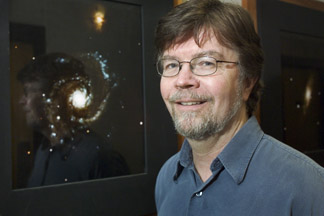Milky Way's fastest pulsar is on its way out of the galaxy, astronomers find
By Lauren Gold Dave Finley

The Milky Way's fastest observed pulsar is speeding out of the galaxy at more than 670 miles a second, propelled largely by a kick it received at its birth 2.5 million years ago.
Using the Very Long Baseline Array (VLBA), 10 radio telescopes spanning 5,000 miles from Hawaii to the U.S. Virgin Islands, James Cordes, professor of astronomy at Cornell University, his former student Shami Chatterjee, now of the Harvard-Smithsonian Center for Astrophysics, and colleagues studied the pulsar (a fast-spinning neutron star) B1508+55, about 7,700 light years from Earth. With the ultra-sharp radio vision of the continentwide VLBA, they precisely measured both the distance and the speed of the pulsar.
The team then plotted the star's motion backward to a birthplace among groups of giant stars in the constellation Cygnus, which contains stars so massive they inevitably explode as supernovae.
Commenting on the research, which was published last fall in Astrophysical Journal Letters, Chatterjee said, "We know that supernova explosions can give a kick to the resulting neutron star, but the tremendous speed of this object pushes the limits of our current understanding. This discovery is very difficult for the latest models to explain." Chatterjee is also a Jansky fellow at the National Radio Astronomy Observatory (NRAO).
The VLBA measurements show the pulsar moving at nearly 1,100 kilometers (more than 670 miles) per second. At this speed, it could travel from London to New York in five seconds.
To measure the pulsar's distance, the astronomers had to detect a very slight wobble in its position caused by the Earth's motion around the sun. This enabled them to calculate the pulsar's speed by measuring its motion across the sky.
"The motion we measured with the VLBA was about equal to watching a home run ball in Boston's Fenway Park from a seat on the moon," Chatterjee said. "However, the pulsar took nearly 22 months to show that much apparent motion. The VLBA is the best possible telescope for tracking such tiny apparent motions."
"The physics is not well understood because the high pulsar speed is the result of the implosion of the core of a star that took only a few seconds about 2.5 million years ago," said Cordes. "The reason this is so different is the precision of it. In astronomy one of the big problems is getting the distance scale. In the past we've identified objects whose velocity we've estimated, but what makes this special is there's no uncertainty in the distance. It's ironclad. There's no wiggle room. It gets rid of any question."
The star's presumed birthplace lies within the plane of the Milky Way, a spiral galaxy. The new VLBA observations indicate that the pulsar now is headed away from the Milky Way's plane with enough speed to leave the galaxy. Since the supernova explosion, the pulsar has moved across about a third of the night sky as seen from Earth.
"We've thought for some time that supernova explosions can give a kick to the resulting neutron star, but the latest computer models of this process have not produced speeds anywhere near what we see in this object," Chatterjee said. "This means that the models need to be checked, and possibly corrected, to account for our observations," he said, noting that other processes could be at work as well.
The observations were part of a larger project to use the VLBA to measure the distances and motions of pulsars. "This is the first result of this long-term project, and it's pretty exciting to have something so spectacular come this early," said NRAO's Walter Brisken, a co-author.
Each of the radio telescopes in the VLBA, which is funded by the National Science Foundation (NSF), has a dish 25 meters (82 feet) in diameter and weighs 240 tons. The VLBA provides astronomers with the sharpest vision of any telescope on Earth or in space.
Chatterjee is lead author of the Astrophysical Journal Letters article. Other co-authors include Joseph Lazio of the Naval Research Laboratory, Miller Goss and Edward Fomalont of NRAO, Stephen Thorsett of the University of California-Santa Cruz, and Andrew Lyne, Wouter Vlemmings and Michael Kramer of Jodrell Bank Observatory. The NRAO is a facility of NSF, operated under cooperative agreement by Associated Universities Inc.
Media Contact
Get Cornell news delivered right to your inbox.
Subscribe